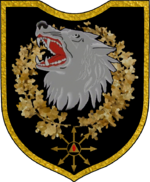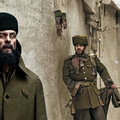State Guard of the Unified Governorates
| State Guard | |
 | |
| Active | 1717 AN – |
|---|---|
| Country | |
| Type | Militia |
| Role |
|
| Size | 2,220,238 (1735 AN) |
| Garrison/HQ | Sansabury |
| Commanders | |
| Legatine-Marshal | Lors Blomqvist |
| Szodan | Daniyal ibn Daniyal |
The State Guard of the Unified Governorates is an ad hoc militia comprised of meritorious subjects called upon by the Civil Executive of the Unified Governorates of Benacia to render aid to the civil power at times of pressing need.
Remit
The State Guard normally serves as an auxiliary force for the realm, activated on the occasion of need, for the purpose of territorial defence. It can also serve as a mobilisation manpower reserve for the Benacian Union Defence Force, and may be called out for partisan warfare operations. During counter-insurgency missions the mobilised State Guard will normally be called upon to establish a cordon around a district or bailiwick in which more specialised agencies would then be free to operate as required.
History
In 1717 AN, 339,648 subjects in the meritorious categories of the Table of Grades and Ranks of the Benacian Union within the governorates of the UGB were called up by the draft lottery and sworn to public service for two years. This mobilisation yielded 283 regimental trained bands, which, between II.1717 and VI.1717, were mustered, drilled, and guarded by officers of the Public Order Forces of the UGB at assembly areas in Litkov, Sansabury, and Stonetree. In VII.1717 the regimental trained bands were assigned to 23 Ersatz Divisions divided between the 11th, 16th, and Siyachier armies of the Central Banner Group of Benacia Command. Six ersatz divisions apiece were assigned to the 11th Army and the Siyachier Army for combat operations, whilst the balance were placed under the 16th Army in Lower Lywall to constitute a pool of replacement manpower, to be called forward as required.
1717–1718 mobilisation
As noted, the UGB was obliged in 1717 AN to call up 1% of the male population within the realm to support Operation Penitent, the introduction of the Protectorate regime into the Garden of Kalgachia.
Based upon the registers maintained by the Benacian Censorate, each Governorate of the realm received a quota to fulfil from the Civil Executive, delivered via the Commissioner for the Circuit of the Realm with jurisdiction over the Governorate in question, which the Governor is then obliged to pass on in turn to the bailiffs of the bailiwicks within his own area of responsibility.
Each bailiwick of the UGB had a designated Fiþnan, or captain, of the BUDF, usually an officer approaching retirement or rusticated on half pay, who served as the defence liaison officer attached to the court of aldermen ruling said bailiwick. This individual, along with whatever staff he has managed to assemble on a limited budget in order to assist in his duties, is responsible for maintaining and raising a militia (minimum 1% of the adult male population of the bailiwick) in times of war or emergency.
In this instance, the defence liaison officers of the bailiwicks were obliged to conduct a draft lottery so as to select 1% of the adult male population of the bailiwick for induction into the state guard, this force being centrally organised upon establishment and therefore distinct from whatever threadbare militias the bailiwicks had organised locally.
Although the orders were phrased in such a way as to suggest that all meritorious adult males were subject to entry into the draft lottery, in practice only the Meritorious, Honourable, and Admirable, were liable for inclusion, as no-one above those grades, namely the ranks of the Illustrious and higher, would deign to obey the orders of a mere captain. Similarly the dependents and retainers of the illustrious were to be considered off limits, lest the captain found himself in an altercation without sufficient political top cover.
For obvious reasons, existing members of the defence and security forces, including the BUDF, the Magisters-Carnifex, the Corps of the Gentlemen-at-Cudgels, the Commission for the Panopticon, the Public Order Forces, Bureau of Coordination and Harmonisation, and doubtless others besides, were exempted from the draft.
Moreover it quickly became apparent that, at the bailiwick level, the Residencies of the Honourable Company and the regional cadres of the N&H were negotiating block exemptions for their employees and members from the draft. This realisation encouraged the Guilds of Benacia and the United Ecclesiastical Corporation of Benacia to also try and seek exemptions from the draft. But here they encountered the iron insistence of higher authority that the assigned quotas be fulfilled in full.
Operation Penitent, once initiated, proved to be mercifully light on actual hostilities. The State Guard had nonetheless been challenged by poor morale, low unit cohesion, inadequate training, shoddy equipment and uniforms, and the consequences of being placed on the bottom rung of the hierarchy of priorities for the overtaxed logistics system of the BUDF and Benacia Command during the campaign. In this sense it was a mercy that the ersatz divisions were not tested in combat.
Mobilised personnel were stood down and returned to their home bailiwicks by mid-1719.
1731 mobilisation
1,332,143 meritorious subjects were called up following the events of the Day of Rage. This number would however be reduced to 275,483 by XIII.1731 AN, allowing the majority of those who had been called up to return to their normal professions, easing the immediate financial burden upon the Unified Governorates.
Nineteen sequentially numbered ersatz (replacement) divisions would remain mobilised after XIII.1731, following the discharge of the majority of those meritorious subjects drafted earlier in the year and the consolidation of those who remained into the aforementioned formations.
Of these, seven divisions were assigned to the Western Banner Group of Benacia Command in Siyachia, whilst a further six were made available to the Central Banner Group in the Governorate of Austland. The remaining six divisions remained under the authority of the civil executive of the UGB, and were assigned to garrison and public order duties.
1733–1734 mobilisation
Further mobilisations during 1733 and 1734, the difficult early years of the Shiro-Benacian War, characterised by the nuclear horror in Alalehzamin and a grinding stalemate thereafter, would see the State Guard enter 1735 with an expanded force of 2,220,238 men under arms, equivalent to 153 divisions, although only 19% of this draft would be assigned to the role of infantry in the Ersatz Divisions, with the remainder performing a variety of combat support and non-combatant roles.
Organisation
Top-level
- State Guard of the Unified Governorates
- General Staff (1%)
- Combatant Corps (19%)
- 1st to 29th Ersatz Divisions
- Commissariat Corps (60%)
- 1st to 21st Supply Services Divisions
- 1st to 20th Field Works Divisions
- 1st to 6th Ordnance Divisions
- Medical Services Division
- Veterinary Services Division
- Commissariats established at the Governorate level
- Inspectorate Corps (20%)
- 1st to 3rd Field Gendarmerie Divisions
- 1st to 16th Security Divisions
- Inspectorates of Recruitment, Training, Standards, and Discipline established at the Governorate level
Ersatz divisions
The Ersatz Division is patterned after the Vanguard Divisions of the Humanist movement, albeit notably being without area defence capability or organic transportation assets.
- Ersatz Division
- Headquarters Echelon (2,400)
- Command & Control Regiment (1,200)
- Reconnaissance Regiment (1,200)
- Combat Echelon (9,600)
- Command & Control Regiment (1,200)
- 1st Demi-Brigade (3,600)
- Regimental trained bands 1 to 6
- 2nd Demi-Brigade (3,600)
- Regimental trained bands 7 to 12
- Penitent Regiment (1,200)
- Force Support Echelon (2,400)
- Commissariat Regiment (1,200)
- Inspectorate Regiment (1,200)
- Penitent Labour Brigade (attached from the Benacian Labour Reserve)
- Administrative Regiment
- Foraging Regiment
- Pioneer Regiment
- Depot Regiment
- General Service Regiments (x2)
- Headquarters Echelon (2,400)
The Penitent Regiment is of especial note, being formed by the least meritorious members of the ersatz division. Whilst these regiments could be filled out with men selected using the scoring matrices favoured by Benacian Censorate, it is more likely that the Penitent Regiment will meet its established manpower total merely by collecting those who attempted to evade the muster after being picked in the draft lottery or else who have subsequently picked up a disciplinary record during the four months of training.
Regimental trained bands
- Regimental Trained Band
- Command Squadron
- Headquarters Troop
- Pioneer Troop
- Scout Troop
- 1st Rifle Squadron
- 2nd Rifle Squadron
- 3rd Rifle Squadron
- Supply Squadron
- Command Squadron
A regimental trained band (RTB) would commence at its muster with 1,200 men taken from amongst the conscripted population of a given bailiwick. By the time, however, that suitable candidates have been drawn off to man the specialist regiments of the ersatz divisions and the least worthy picked out for incorporation into the penitent regiment, this figure will have easily halved to 600 men, becoming a demi-regiment in all but name. It is on the basis of being a five squadron formation therefore that the RTB is organised.
Uniforms
The uniforms of the State Guard were closely modelled on the Pattern M1717 Service Uniform of the BUDF, albeit of a lesser quality. Personnel were also issued with the Pattern M1717 Fatigue Uniform, which was to be worn for labour duty when assigned to work party contingents.
-
State Guard officer uniform
-
Levied guardsmen of a regimental trained band
-
Example of the Fatigue Uniform issued to State Guard personnel
Rations
Standard rations, in addition to the usual weekly entitlements, include a supplementary daily allowance of 460 grams of biscuit, 420 grams of salted beef, 400 grams of pickled cabbage, onions, and peas, along with 5 litres of beer or three litres of wine, subject to availability.


